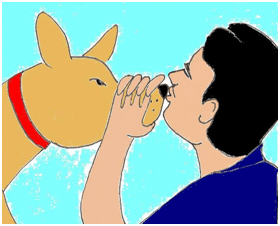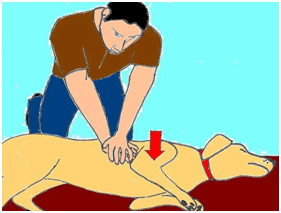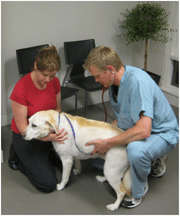How To Give A Cat Or Dog CPR
Cardiopulmonary Cerebral Resuscitation for Pets
PROBLEM: MY PET HAS STOPPED BREATHING
Mouth to nose resuscitation can be used. This is known as rescue breathing.
- Close your pets’ mouth and cup your hand over its nose to make a tube.
- Make a seal and blow into the nostrils until you see the chest rise.
- Do this every 3 – 6 seconds until your pet gets to the hospital or breathes on its own.
Your pets gum colour may become pinker with this technique as oxygen reaches the lungs.
Animals can stop breathing when they become paralysed, such as with snake bite, tick paralysis, blowfish ingestion or spinal trauma. In these situations, the heart is often still beating so full CPR is not required. Rescue breathing alone can be life saving and is relatively easy to perform.
PROBLEM: MY PET’S HEART HAS STOPPED BEATING
Place your pet on its side.
- Feel for the heart where the elbow meets the chest. This can be difficult in fatter dogs and so you will need to press hard.
- With one hand over another, place the hand palm down just behind the point of the elbow.
- Press down continuously at a rate of 120 times per minute (two times a second) until the heart starts beating again.
For smaller pets, you can use one hand, placing your fingers and thumb on opposite sides of the chest and squeeze together as fast as you can (usually 120times per minute).
If able to do so, make a note of the time you started. Your pets gum colour should become pink as blood is pushed around the body.
If there is one other person to help, give breaths at the same time as compressions. Do not stop compressions in order to give a breath. If there is no one to help, give 2 breaths after every 15-30 compressions.
You should try to continue CPR until you can get your pet to the professionals. Bystander CPR is associated with a much higher chance of survival than no CPR. If your pet regains consciousness or you can feel a regular heart beat, you can stop compressions and make sure the pet is breathing.
Trauma Symptoms | Vomiting Pets | Heat Stroke Symptoms | Pet Life Support

 Mouth to nose resuscitation can be used. This is known as rescue breathing.
Mouth to nose resuscitation can be used. This is known as rescue breathing. Place your pet on its side.
Place your pet on its side.


